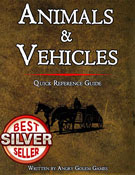Large beast (animal), unaligned
Armor Class 12
Hit Points 34 (4d10+12)
Speed 25 ft.
Proficiency Bonus +2
Proficiency Bonus +2 (5th Edition Advanced Mode)
| STR | DEX | CON | INT | WIS | CHA |
|---|---|---|---|---|---|
| 19 (+4) | 8 (-1) | 16 (+3) | 2 (-4) | 9 (-1) | 5 (-3) |
Skills Perception +1
Senses passive Perception 9
Challenge 1/4 (50 XP)
Beast of Burden. The ox is considered to be a Huge animal for the purpose of determining its carrying capacity.
Sure-Footed. The ox has advantage on Strength and Dexterity saving throws made against effects that would knock it prone.
ACTIONS
- Multiattack. The ox makes two attacks with its horns.
- Horns. Melee Weapon Attack: +6 to hit, reach 5 ft., one target. Hit: 7 (1d6 + 4) piercing damage.
DESCRIPTION
An ox is a large, domesticated bovine animal that is mainly used for draft work rather than meat or milk. Oxen are typically castrated male cattle, but the term can also refer to any adult cattle of either sex. Oxen have thick, muscular bodies, short legs, and long horns that curve outward. Their fur can vary in color, from brown to black to white. Oxen are often yoked together in pairs or teams to pull heavy loads, such as plows, carts, or wagons. Oxen are loyal, hardworking, and docile creatures that can endure harsh conditions and long hours of labor.
COMBAT
Oxen are not aggressive by nature, but they will defend themselves or their mates if threatened. An ox can use its powerful horns to gore an enemy with a swift charge, inflicting piercing damage. An ox can also trample smaller creatures under its hooves, causing bludgeoning damage. Oxen have a natural armor that protects them from some attacks, but they are vulnerable to fire and slashing weapons. Oxen are not very fast or agile, but they have a high strength and constitution that make them resilient and enduring.
HABITAT / SOCIETY
Oxen are domesticated animals that live in farms, villages, or towns where they are used for work or transportation. Oxen are herbivorous and graze on grass, hay, or grains. They need a lot of water and food to sustain their large bodies and energy demands. Oxen are social animals that form bonds with their mates and handlers. They can communicate with each other through low grunts, moos, or snorts. Oxen are intelligent and can learn simple commands and tasks from their owners. Oxen are valued for their usefulness and reliability, but they are also treated with respect and care by most people.
ECOLOGY
Oxen are an important part of the ecology of many regions, as they help cultivate the land, transport goods and people, and provide manure for fertilization. Oxen have few natural predators, as they are usually protected by their owners or by fences. However, some wild animals, such as wolves, bears, or lions, may attack oxen if they are hungry or provoked. Oxen may also fall prey to diseases or parasites that affect cattle. Oxen have a lifespan of about 20 years, and they reproduce by mating with other cattle. A female ox (cow) can give birth to one calf every year after a gestation period of nine months. A male ox (bull) can sire many offspring with different cows.
Oxes can be used as mounts or pulling animals for vehicles.
The statistics are detailed in the D&D 5e Animals & Vehicles reference guide. Just have a look at the preview on DrivethruRpg.
